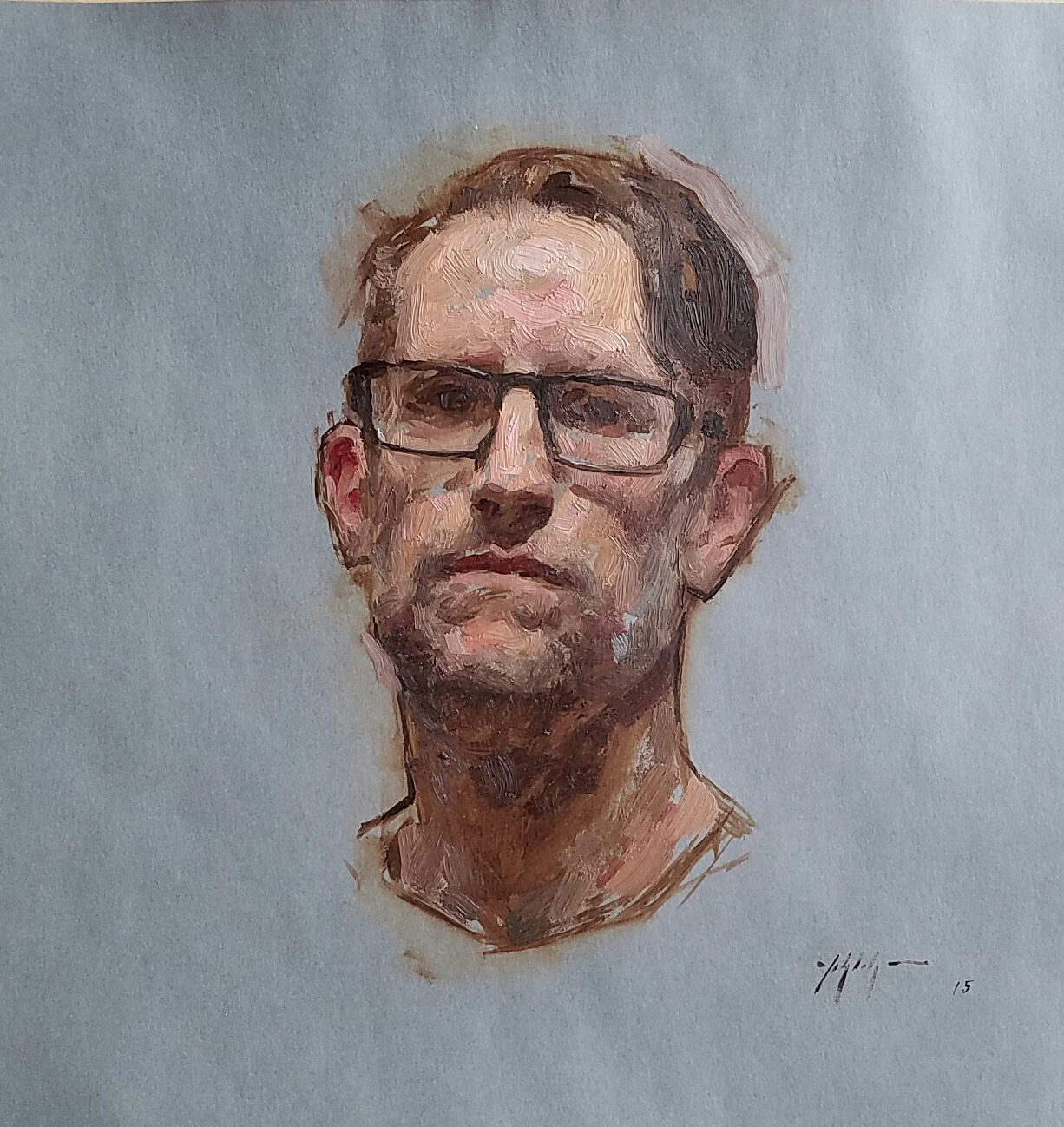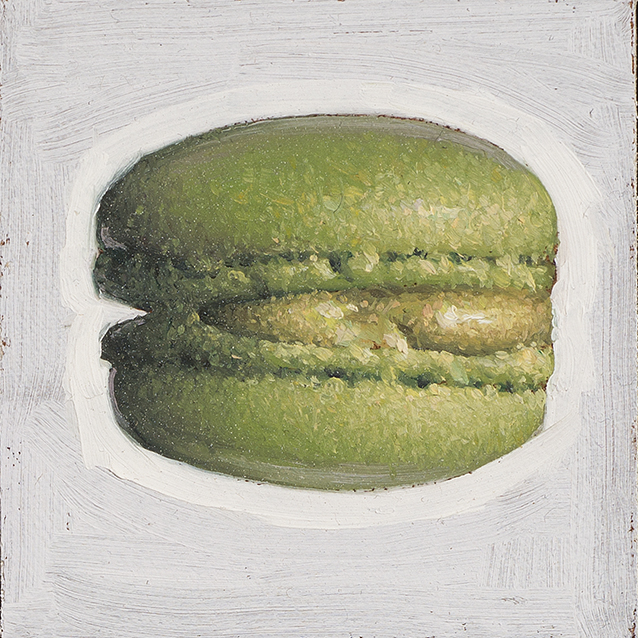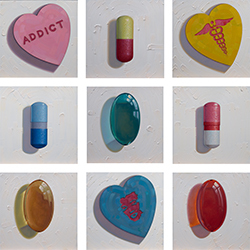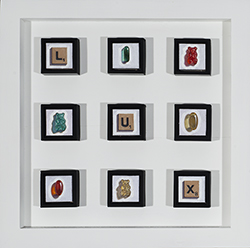Anthony Mastromatteo
(Born 1970)
Pistachio Macaron
Oil on canvas-panel
2 x 2 inches
Signed
BIOGRAPHY - Anthony Mastromatteo (Born 1970)

Looking at Anthony Mastromatteo’s childhood in retrospect, it’s unlikely that anyone would have imagined that he would grow up to become an artist. Born on January 19, 1970 in suburban Akron, Ohio, Mastromatteo enjoyed a pleasant childhood. He was the oldest of three sons and excelled during these years at both soccer, receiving first team All-American honors during his senior season, and school, graduating at the top of his class at the local Jesuit high school.
What was not present was any interest in the arts until his senior year in high school. At that point, he and some friends made a trip to the Cleveland Museum of Art where he saw J. M. W. Turner’s painting, The Burning of the Houses of Lords and Commons, 16 October 1834 (1835). According to Mastromatteo, “It made sense to me.” In the fall of 1988, he left Ohio for Princeton University where he enrolled in an art history class, Neoclassicism to Impressionism, because he had been impressed by that Turner painting and wanted to understand exactly what that earlier experience suggested.
One of the assignments in the art history class was a term paper about a painting that the student could see in person. Mastromatteo decided to travel to the Fogg Museum (now part of the Harvard Art Museums) to see Vincent van Gogh’s Self-Portrait Dedicated to Paul Gauguin (1888), often called the artist’s Buddhist self-portrait. [i] Again, Mastromatteo recognized a sense of connection, a sense of self, similar to what he had felt when he first saw Turner’s painting in Cleveland. This encounter with art, and the power of painting to establish an emotional association across time, led Mastromatteo to major in art history under the guidance of James Marrow. His senior thesis was a study of another self-portrait, Albrecht Dürer’s Self-Portrait of 1500 (Alte Pinakothek, Munich).
After graduation in 1992, the young art historian set out for New York city where he worked at Christie’s for the next five years. The world of the international auction house proved to be an education not only in the art market, but also in the vast scope of art history itself. As Mastromatteo notes, “art history is not just what you learn in class.” Surrounded by innumerable works of art, it was obvious that both the range of quality and artists was prodigious.
Gradually, he began to consider the possibility of becoming an artist himself, and in the fall of 1996, he enrolled in classes at the Art Students League. His initial focus was on drawing and figurative painting. Because of his knowledge of art history and his exposure to the boundless array of paintings available on the art market, Mastromatteo was particularly conscious of questions about how representational art varied over time. The Pre-Raphaelite art of the nineteenth century, which was frequently seen at Christie’s auctions in 1990s, posed intriguing questions about the relationship between medievalism and modernism. Just as Dürer strove to reflect the textures, colors and forms of his own time, the Pre-Raphaelite painters paid attention to creating a system of representation that reflected their tangible observation of the world. The inclusion of medieval costumes and narratives, however, referenced an imaginary evocation of an earlier era rather than the daily reality of their lives. This apparent contradiction led to the question of how to define realism as a system of symbols in contemporary terms. As Mastromatteo comments now, “Reality demands that I pay attention to it...whether it’s a person, place or thing.”
Within a year of his initial classes at the Art Students League, Mastromatteo’s friend Sarah Lamb introduced him to Jacob Collins at the Water Street Atelier in Brooklyn. It was clear from the outset that Collins’ work was something he wanted to investigate. Once he decided to pursue his studies at Water Street, Mastromatteo left Christies to devote his attention full-time to becoming a visual artist.
During this same period, Mastromatteo first met Stella Munoz Rodriguez, the woman he would marry in 1999. Mastromatteo continued to study through 2002 when he made the transition to living as a professional painter. In spite of some early success in New York City and after having signed a representation agreement with Spanierman Gallery, Mastromatteo and his wife moved back to Ohio in 2004.
That move was both challenging and rewarding. Although the Ohio location has “meant more need to hustle”, it has also opened up the painter’s creativity. In spite of working in a studio without heat in his first years back in Akron, he has no regrets. The lack of a “ready-made art world” has meant that Mastromatteo had to find sources for intellectual engagement outside of himself. He has become an even more avid reader, embracing both historical and contemporary writings on philosophy, science and literature; and he has continued to follow the discipline of working that he was instilled in him by the Jesuits in high school; as he notes, “the strict habit of working” has served him well.
Nowhere is that more evident than in Mastromatteo’s diverse reading list, which encompasses James Joyce as well as a numerous medieval and contemporary philosophers including Thomas Aquinas, John Duns Scotus, Gottfried Leibniz, Martin Heidegger, Maurice Merleau-Ponty, Gilles Deleuze, Michel Serres and Gaston Bachelard. [ii] At the core of much of his reading are questions about perception, about “how the knowledge of reality affects the way we experience reality”. As an artist, he is especially curious about how the “process of creativity functions as a way of engaging the real world”. This type of philosophical inquiry both supports Mastromatteo’s art work and keeps him connected to a larger intellectual world of scholarship and exploration. As he remarks, “It is a choice to read widely and learn.”
Living in Akron has also meant that the cost of living is reasonable and Mastromatteo has the luxury of being able to take more risks with his art. He can explore ideas more freely without feeling pressure to fit his work into a particular category. Today, the unheated studio has been replaced by a dedicated space at home where he can paint and take care of his daughter, who was born in 2006.
Looking ahead, Mastromatteo foresees a continued exploration of painting, but he is also interested in building his business. The knowledge gained from his years at Christies gave him a singular perspective about the inherent value versus the perceived value of art. That in turn raises questions about how to create value and simultaneously maintain integrity in a market that is often fickle. Mastromatteo’s natural tendency toward philosophical discourse finds a place in all aspects of his work, enabling him not only to appreciate the historical context of ideas, but also to relate them to the specific and tangible images that he creates.
Janet Whitmore, Ph.D.
[i] Although the Fogg Museum uses the title Self-Portrait Dedicated to Paul Gauguin, van Gogh described the portrait as “a simple worshipper of the eternal Buddha.” See Letter 695 to Paul Gauguin, Wednesday, 3 October 1888 at vangoghletters.org.
[ii] For a brief introduction to the life and work of these philosophers, see the Stanford Encyclopedia of Philosophy at: https://plato.stanford.edu
| AVAILABLE WORKS | |||



